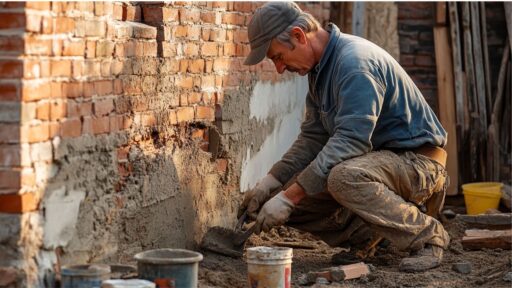Home maintenance is often viewed as a list of hands-on tasks—cleaning gutters, replacing filters, sealing drafts, or checking for roof damage. And while all of those are important, they only represent the execution side of the equation.
The foundation of effective home maintenance isn’t just found in your toolbox—it’s found in how well you plan.
Whether you’re a homeowner, landlord, or property manager, a clear, proactive maintenance plan will save you time, money, and major stress. It will help you stay ahead of issues, maintain property value, and turn emergency repairs into predictable upkeep.
So why do most people still approach maintenance reactively? More importantly, how can you shift to a smarter, more strategic system?
Let’s explore.
The True Cost of Waiting Until Something Breaks
We’ve all been there: a faucet starts leaking, or the water heater gives out in the middle of winter. Most homeowners don’t act until something forces their hand. That’s reactive maintenance—and it’s the most expensive way to care for your home.
Minor repairs that go unnoticed or ignored can escalate quickly:
- A cracked seal on a window becomes water damage.
- A loose shingle becomes a roof leak.
- A noisy furnace becomes a total system failure.
The fixable becomes costly. The inconvenient becomes urgent.
Reactive maintenance isn’t just stressful—it’s inefficient. That’s why building a simple, reliable home maintenance plan is crucial.
What Proactive Home Maintenance Actually Looks Like
Proactive maintenance means regularly inspecting and maintaining key systems in your home before they fail. It involves a bit of structure, a little time each month, and a solid understanding of seasonal priorities.
Here’s a framework to get started:
Seasonal Maintenance Checklists
Every season brings different challenges. Create checklists for:
Spring
- Check roof and siding for winter damage
- Service AC units before summer use
- Inspect caulking and weather stripping
Summer
- Power wash exterior surfaces
- Re-seal deck and outdoor woodwork
- Test irrigation systems
Autumn
- Clean and inspect gutters and downspouts
- Check heating system for winter readiness
- Inspect windows and doors for drafts
Winter
- Insulate exposed pipes
- Test smoke and carbon monoxide detectors
- Inspect attic for moisture or leaks
Budgeting for Maintenance
It’s smart to set aside 1% to 3% of your home’s value annually for upkeep. If your home is worth $300,000, that’s $3,000 to $9,000 each year. While not all of that may be used, having the budget prevents financial surprises.
Quarterly Walkthroughs
Set a reminder every three months to walk through your home. Check for:
- Leaks or stains
- Cracks in walls or ceilings
- Appliance wear
- Pest activity
- Moisture in the basement or attic
Taking 30 minutes to inspect your home can prevent major issues later on.
Think of Your Home as a Project—and You’re the Manager
Managing a home isn’t just about fixing things. It’s about overseeing a long-term investment.
In many ways, homeownership mirrors project management:
- Scheduling and prioritizing tasks
- Managing budgets and materials
- Hiring or coordinating with professionals
- Reducing risk with early action
- Evaluating performance over time
This mindset is especially valuable when tackling bigger projects—like a bathroom remodel, garage conversion, or structural repair. In fact, professionals in the construction industry take this even further by creating formal business plans to outline scope, costs, risks, and goals.
If you’ve ever considered launching a property renovation or contracting business, this mindset becomes even more important. In those cases, using a detailed construction business plan template is essential. It helps aspiring builders and small business owners create a clear roadmap for operations, pricing, project timelines, and long-term growth. The same structured thinking that drives successful companies can dramatically improve how you maintain and invest in your own home.
Why Planning Protects More Than Just Your Property

A well-maintained home is more than a polished exterior or functional plumbing. It’s a safer, more efficient, and more enjoyable space to live in.
Here’s what a proactive maintenance plan really protects:
1. Your Time
When maintenance is planned, you’re not scrambling to respond to emergencies. That means fewer last-minute repairs and more weekends to relax.
2. Your Money
Routine care is cheaper than repairs. Regular HVAC servicing, for example, can extend the life of your system and reduce energy costs.
3. Your Health
Leaks, mold, or dirty filters can have a direct impact on indoor air quality and your family’s well-being.
4. Your Home’s Value
A well-maintained property holds its value longer and attracts higher offers if you decide to sell.
Tools and Systems That Make It Easy
Getting organized doesn’t require specialized software. Here are basic tools you can start using today:
Maintenance Log
Track what you’ve done and when. This is especially useful for seasonal jobs or documenting service provider visits.
Calendar Reminders
Set digital reminders for tasks like gutter cleaning, HVAC servicing, and filter replacements.
Spending Tracker
Monitor your maintenance spending to keep your budget on target and identify trends.
Preferred Provider List
Create a go-to list of plumbers, electricians, handymen, and specialists you trust. This saves time during emergencies.
Planning Is for Everyone—Not Just Homeowners
Even if you rent, own a second property, or manage a portfolio of homes, a planning-based approach can save money and headaches.
For Renters:
Stay ahead of issues and communicate early with landlords. You’ll avoid larger problems and protect your deposit.
For Landlords:
Preventative maintenance preserves property value and reduces costly turnover.
For DIY Homeowners:
Planning your own projects can prevent overspending, missed steps, and rework. Even routine upgrades can benefit from clear goals and schedules.
Conclusion: A Smarter Way to Care for the Place You Call Home
There’s no such thing as a maintenance-free home. But there is such a thing as maintenance you control.
When you plan ahead, you take ownership of your space in a meaningful, empowering way. You don’t just react—you manage. You don’t just patch—you preserve.
Your home is more than a place to live—it’s one of the biggest investments you’ll ever make. Treat it accordingly. Start with a plan, adapt as you go, and build systems that help you stay on top of what matters.
Because when you care for your home with intention, you don’t just protect it—you grow with it.








